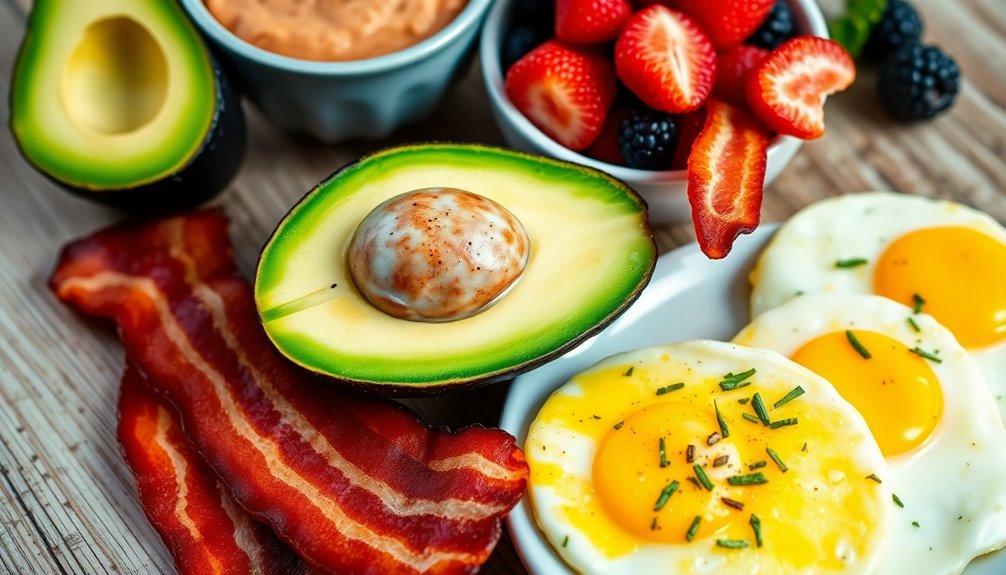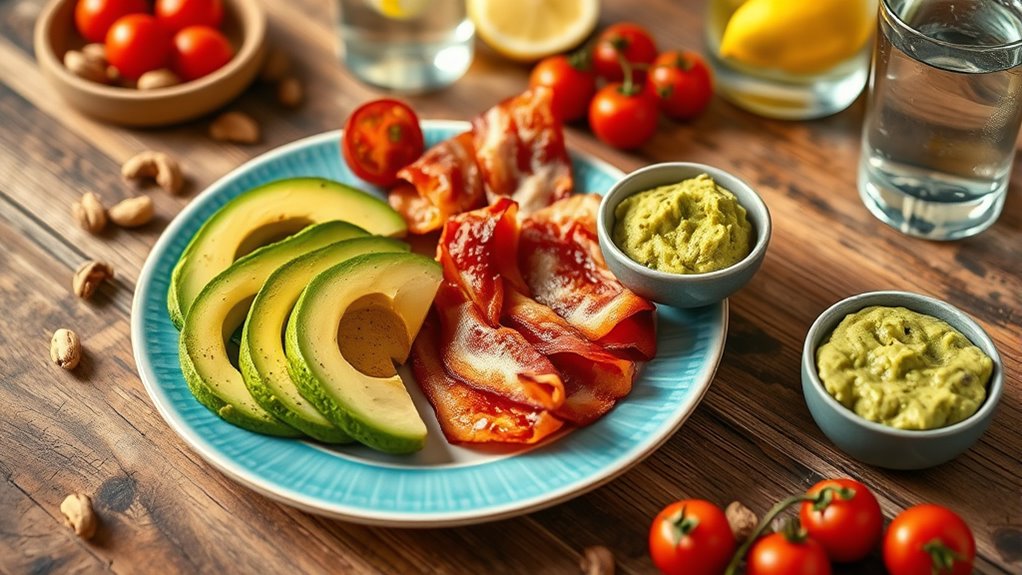The keto diet is a low-carb, high-fat plan that encourages your body to enter ketosis, a state where it burns fat for fuel instead of carbs. To succeed, you’ll need to limit carbs to around 20-50 grams daily and focus on healthy fats, moderate protein, and keto-friendly foods. Planning meals and snacks helps you stay on track and avoid cravings. Keep going for more tips to make your keto journey easier and more effective.
Key Takeaways
- The keto diet is a low-carb, high-fat plan that promotes ketosis, a metabolic state where fat becomes the primary fuel source.
- Achieving ketosis involves limiting daily carbohydrate intake to about 20-50 grams and focusing on healthy fats and moderate protein.
- Planning meals and snacks with keto-friendly ingredients helps maintain macros, prevents carb cravings, and supports sustained fat burning.
- Common keto foods include avocados, nuts, fatty fish, eggs, cheese, and leafy greens, while avoiding sugar and processed carbs.
- Tracking your intake and staying hydrated are essential for success and adapting smoothly to the low-carb, high-fat lifestyle.

The keto diet, also known as ketogenic diet, is a low-carb, high-fat eating plan designed to shift your body into a state of ketosis. In ketosis, your body burns fat for fuel instead of carbohydrates, which can lead to weight loss and improved energy levels. To succeed on this diet, you need to focus on keto meal planning. This means selecting foods that are rich in healthy fats, moderate in protein, and very low in carbs. Start by stocking up on keto-friendly ingredients like avocados, nuts, seeds, fatty fish, olive oil, and leafy greens. Planning your meals ahead of time helps prevent last-minute temptations and guarantees you stay within your carb limits. Creating a weekly meal plan allows you to balance your macros and avoid accidental carb overload. When it comes to snacks, choose options that support your ketosis goals. Keto-friendly snacks are typically high in fat and low in carbs, making them perfect for curbing hunger between meals. Some popular choices include cheese slices, hard-boiled eggs, nuts, or celery with cream cheese. Having these snacks on hand means you won’t be tempted to reach for carb-heavy options like chips or candy. Incorporating variety into your keto meal planning keeps your diet interesting and sustainable. You can experiment with different recipes, from cauliflower rice to zucchini noodles, ensuring you don’t get bored. It’s also helpful to keep track of your carbohydrate intake, aiming for around 20-50 grams per day, depending on your goals. Using a food journal or app can simplify this process. Staying consistent with your meal planning and snack choices helps your body adapt more quickly to ketosis, leading to more effective fat burning and energy. Remember, the key to a successful keto diet is preparation. When you plan your meals and snacks, you set yourself up for success and reduce the chances of slipping into old eating habits. Over time, your taste buds will adjust, and you’ll find it easier to choose keto-friendly options naturally. Keep in mind that staying hydrated and maintaining electrolyte balance are essential, especially in the beginning. If you feel hungry or deprived, it’s often a sign to revisit your meal plan and make sure you’re getting enough fats and nutrients. Additionally, understanding the importance of vetted information can help you make informed decisions about your diet and avoid misinformation. Being aware of the role of natural ingredients in your diet can also support your overall health and adherence to the keto lifestyle. Incorporating accurate nutritional data from reputable sources can further optimize your meal planning and ensure you stay within your desired macros. Recognizing the psychological aspects of habit formation can also help you stay committed and motivated throughout your keto journey. Overall, keto meal planning and having a stash of keto-friendly snacks are essential tools for making your transition into ketosis smooth and sustainable. With a little preparation, you’ll be on your way to enjoying the benefits of a low-carb, high-fat lifestyle.
Frequently Asked Questions
Can I Eat Fruit on a Keto Diet?
You might wonder if you can eat fruit on a keto diet. While many fruit varieties are high in carbs, some low-carb options like berries can fit into your plan in moderation. Keep an eye on the carb content of each fruit, and limit your intake to stay within your daily carb target. This way, you can enjoy a bit of fruit without knocking yourself out of ketosis.
How Long Does It Take to Enter Ketosis?
Oh, the suspense! You’re anxious to know how long until your body starts playing the fat adaptation game and enters ketosis. Well, it varies—some folks hit it in as little as 2-4 days, while others take a week or more. Your metabolic adaptations kick in gradually as your body shifts from carbs to fat burning. Patience is key; give your body time to embrace this new, keto-powered lifestyle.
Is the Keto Diet Safe Long-Term?
You might wonder if the keto diet is safe long-term. While many people find it effective, it can cause nutritional deficiencies if you’re not careful with food choices. Long-term sustainability varies for each person, so it’s crucial to monitor your health and consult with a healthcare professional. With proper planning, you can minimize risks and enjoy the benefits, but staying informed helps guarantee you’re making the best decision for your well-being.
What Are Common Keto Flu Symptoms?
A stitch in time saves nine, and knowing keto flu symptoms helps you prepare. You might experience electrolyte imbalance, leading to fatigue and dizziness. Other signs include headaches, muscle cramps, and irritability. These symptoms usually occur as your body adjusts to ketosis. Staying hydrated, replenishing electrolytes, and resting can ease your *shift*. Remember, these temporary discomforts are part of the process, and with patience, you’ll soon adapt.
Can I Build Muscle on Keto?
Yes, you can build muscle on keto. Focus on proper workout nutrition, ensuring you consume enough protein to support muscle growth while maintaining ketosis. Incorporate healthy fats for energy during your workouts, and prioritize strength training exercises. Though it might take some adjustment, many people successfully build muscle on a keto diet by balancing macronutrients and staying consistent with their workouts.
Conclusion
Now that you understand the basics of the keto diet, you’re ready to start your low-carb journey. Remember, over 60% of people who switch to keto report increased energy and mental clarity within just a month. Keep your focus on wholesome fats, lean proteins, and plenty of greens. Stay consistent, listen to your body, and enjoy the process. With dedication, you’ll soon experience the many benefits of ketosis and a healthier lifestyle.









